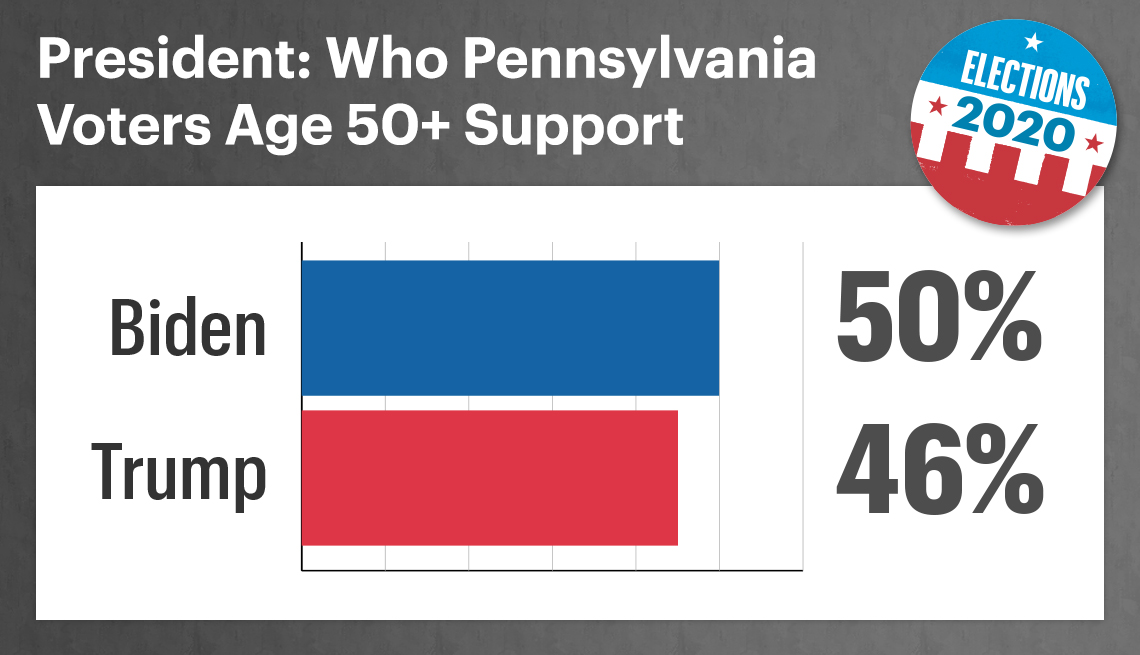AARP Hearing Center

More than half (55 percent) of Pennsylvania voters age 50 and older are worried about getting the coronavirus, and almost half (47 percent) are concerned they won’t be able to afford the health care that they or their family need, according to a new AARP poll that finds older voters could decide the 2020 elections.
The poll also shows that 90 percent of older Pennsylvanians are more likely to vote for candidates who support allowing Medicare to negotiate with pharmaceutical companies for lower prescription drug prices, and 88 percent are more likely to support nominees who promise to protect Social Security from benefit cuts.
These results show that, despite the strong partisan divisions in the country, “there are some foundational programs that cut across these divisions — notably Social Security and Medicare,” says John Hishta, AARP senior vice president for campaigns. “These are areas that 50-plus voters care deeply about, no matter where they stand. And it shows that the candidates should be addressing those issues with these voters.”
The full results of the public opinion survey, released Tuesday, also found that 90 percent of those polled are worried that Congress won’t deal with the problems they face, and 86 percent are concerned that America is becoming even more divided.
Other key findings in the poll:
- 75 percent of 50-plus Pennsylvania voters are worried there will be cuts to Social Security to pay for new spending and the budget crisis.
- 88 percent say they would be more likely to vote for a candidate who supports strengthening Medicare.
- 82 percent will support candidates who favor increasing protections on nursing home residents during the coronavirus pandemic.
- 82 percent also favor elected officials who will support making available quality, affordable long-term care options, including for home care and nursing homes.
In the presidential race, former Vice President Joe Biden holds a small 49 percent to 46 percent lead over President Donald Trump among likely Pennsylvania voters, a new AARP public opinion survey finds. Among 50-plus voters, Biden leads 50 percent to 46 percent.
Pennsylvania is among a group of competitive battleground states where this fall’s results could decide the presidency.
“We believe 50-plus voters are going to play a critical role in this year’s election,” said Nancy LeaMond, AARP’s executive vice president and chief advocacy and engagement officer. She pointed out that while Americans age 50 and over comprise 45 percent of the voting population, they accounted for 56 percent of the ballots cast in 2016. “They punch above their weight,” she added.
The AARP survey also found that voters 50-plus in Pennsylvania do not support the way Trump has managed the coronavirus pandemic. Among these voters, 46 percent support the president’s management of the crisis, while 53 percent oppose it.
In addition, fewer than half (45 percent) of Pennsylvania’s 50-plus electorate say they would get a COVID-19 vaccine, while 26 percent say they aren’t sure if they would get it.
The survey also found that a majority of Pennsylvanians over age 50 (58 percent) plan to cast their ballot in person on Election Day, while 36 percent said they will not vote in person. Pennsylvanians may vote by mail but there is no early in-person voting in the commonwealth.
AARP’s Protect Voters 50+ campaign is designed to help make sure that even as America continues to deal with the coronavirus crisis, that all voters get the information they need to safely cast their ballot. AARP is working in every state to educate older voters on voting options.
“One thing we know is that virtually all older voters plan to vote this year,” said LeaMond. “They want to vote; they want their voices heard and they’re going to find a way to do that that’s safe.”
AARP commissioned Benenson Strategy Group and GS Strategy Group to conduct telephone surveys in six presidential battleground states, including Pennsylvania. The pollsters interviewed 1,600 likely voters in the state between Aug. 28 and Sept. 8. The results have a margin of error of plus or minus 2.5 percent.
Also of Interest
































































